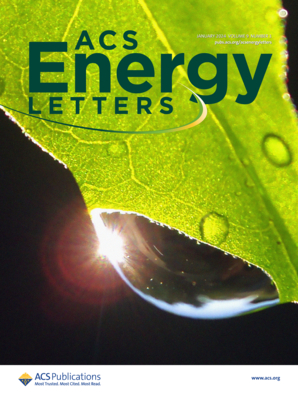利用卤化物钙钛矿纳米晶体从甲醇蒸气中产生光驱动氢
IF 18.2
1区 材料科学
Q1 CHEMISTRY, PHYSICAL
引用次数: 0
摘要
卤化物钙钛矿的制备简便、结构可调节性和独特的光学性质使其在太阳能电池和发光器件中取得了巨大的成功。然而,由于它们在低成本极性溶剂(如甲醇和水)中的不稳定性,它们在光催化中的应用目前比较滞后,通常需要特殊的封装。在此,我们证明了卤化物钙钛矿(MAPbBr3, CsPbBr3)纳米晶体在Pt共催化剂存在的情况下作为质子源在甲醇/水蒸气光催化制氢方面是稳定的。在甲醇蒸气中,最佳的MAPbBr3钙钛矿NC膜在太阳照射下稳定析氢约20 h,析氢速率达到424 μmol·g-1·h - 1。值得注意的是,时间分辨光谱显示,电子-空穴对向Pt团簇的扩散限制供能主导了电荷转移动力学。这项研究显示了在极性环境中直接使用卤化物钙钛矿进行光驱动反应的潜力。本文章由计算机程序翻译,如有差异,请以英文原文为准。

Light-Driven Hydrogen Generation from Methanol Vapor Using Halide Perovskite Nanocrystals
The facile preparation, structural tunability, and unique optical properties of halide perovskites have led to great success in solar cells and light-emitting devices. However, due to their instability in low-cost polar solvents (e.g., methanol and water), their application in photocatalysis is currently lagging and usually requires special encapsulation. Herein, we demonstrate that halide perovskite (MAPbBr3, CsPbBr3) nanocrystals are stable for photocatalytic hydrogen production from methanol/water vapor as proton sources without special protection in the presence of Pt cocatalysts. In methanol vapor, an optimal MAPbBr3 perovskite NC film exhibits steady hydrogen evolution for ∼20 h under solar irradiation, reaching a marked hydrogen evolution rate of 424 μmol·g–1·h–1. Notably, time-resolved spectroscopies reveal that the diffusion-limited feeding of electron–hole pairs toward Pt clusters dominates the dynamics of charge transfer. This study shows the potential of directly using halide perovskites for light-driven reactions in polar environments.
求助全文
通过发布文献求助,成功后即可免费获取论文全文。
去求助
来源期刊

ACS Energy Letters
Energy-Renewable Energy, Sustainability and the Environment
CiteScore
31.20
自引率
5.00%
发文量
469
审稿时长
1 months
期刊介绍:
ACS Energy Letters is a monthly journal that publishes papers reporting new scientific advances in energy research. The journal focuses on topics that are of interest to scientists working in the fundamental and applied sciences. Rapid publication is a central criterion for acceptance, and the journal is known for its quick publication times, with an average of 4-6 weeks from submission to web publication in As Soon As Publishable format.
ACS Energy Letters is ranked as the number one journal in the Web of Science Electrochemistry category. It also ranks within the top 10 journals for Physical Chemistry, Energy & Fuels, and Nanoscience & Nanotechnology.
The journal offers several types of articles, including Letters, Energy Express, Perspectives, Reviews, Editorials, Viewpoints and Energy Focus. Additionally, authors have the option to submit videos that summarize or support the information presented in a Perspective or Review article, which can be highlighted on the journal's website. ACS Energy Letters is abstracted and indexed in Chemical Abstracts Service/SciFinder, EBSCO-summon, PubMed, Web of Science, Scopus and Portico.
 求助内容:
求助内容: 应助结果提醒方式:
应助结果提醒方式:


